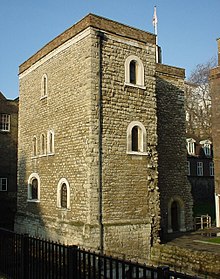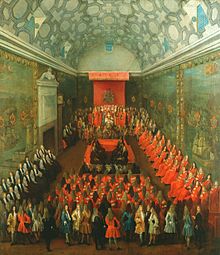User:Ltwin/Sandbox 6
House of Lords of England (currently a redirect)
Organization and procedures[edit]

The House of Lords met in in the White Chamber of the Old Palace of Westminster.
History[edit]

Text copied from House of Lords history section
Today's Parliament of the United Kingdom largely descends, in practice, from the Parliament of England, through the Treaty of Union of 1706 and the Acts of Union that ratified the Treaty in 1707 and created a new Parliament of Great Britain to replace the Parliament of England and the Parliament of Scotland. This new parliament was, in effect, the continuation of the Parliament of England with the addition of 45 Members of Parliament (MPs) and 16 Peers to represent Scotland.
The House of Lords developed from the "Great Council" (Magnum Concilium) that advised the king during medieval times.[1] This royal council came to be composed of ecclesiastics, noblemen, and representatives of the counties of England and Wales (afterwards, representatives of the boroughs as well). The first English Parliament is often considered to be the "Model Parliament" (held in 1295), which included archbishops, bishops, abbots, earls, barons, and representatives of the shires and boroughs.
The power of Parliament grew slowly, fluctuating as the strength of the monarchy grew or declined. For example, during much of the reign of Edward II (1307–1327), the nobility was supreme, the Crown weak, and the shire and borough representatives entirely powerless.
During the reign of Edward II's successor, Edward III, Parliament clearly separated into two distinct chambers: the House of Commons (consisting of the shire and borough representatives) and the House of Lords (consisting of the archbishops, bishops, abbots and nobility). The authority of Parliament continued to grow, and during the early 15th century both Houses exercised powers to an extent not seen before. The Lords were far more powerful than the Commons because of the great influence of the great landowners and the prelates of the realm.
The power of the nobility declined during the civil wars of the late 15th century, known as the Wars of the Roses. Much of the nobility was killed on the battlefield or executed for participation in the war, and many aristocratic estates were lost to the Crown. Moreover, feudalism was dying, and the feudal armies controlled by the barons became obsolete. Henry VII (1485–1509) clearly established the supremacy of the monarch, symbolised by the "Crown Imperial". The domination of the Sovereign continued to grow during the reigns of the Tudor monarchs in the 16th century. The Crown was at the height of its power during the reign of Henry VIII (1509–1547).
The House of Lords remained more powerful than the House of Commons, but the Lower House continued to grow in influence, reaching a zenith in relation to the House of Lords during the middle 17th century. Conflicts between the King and the Parliament (for the most part, the House of Commons) ultimately led to the English Civil War during the 1640s. In 1649, after the defeat and execution of King Charles I, the Commonwealth of England was declared, but the nation was effectively under the overall control of Oliver Cromwell, Lord Protector of England, Scotland and Ireland.
The House of Lords was reduced to a largely powerless body, with Cromwell and his supporters in the Commons dominating the Government. On 19 March 1649, the House of Lords was abolished by an Act of Parliament, which declared that "The Commons of England [find] by too long experience that the House of Lords is useless and dangerous to the people of England."[2] The House of Lords did not assemble again until the Convention Parliament met in 1660 and the monarchy was restored. It returned to its former position as the more powerful chamber of Parliament—a position it would occupy until the 19th century.


Citations[edit]
References[edit]
- Foster, Elizabeth Read (1983). The House of Lords, 1603-1649: Structure, Procedure, and the Nature of Its Business. University of North Carolina Press. ISBN 0807815330.
- ^ Loveland (2009) p. 158
- ^ "March 1649: An Act for the Abolishing the House of Peers.". Acts and Ordinances of the Interregnum, 1642–1660. His Majesty's Stationery Office. 1911 – via British History Online.

